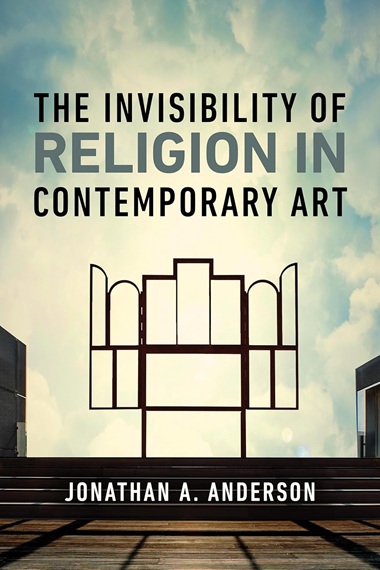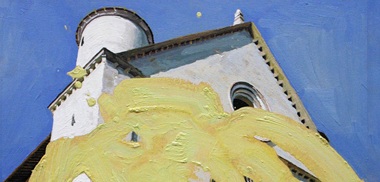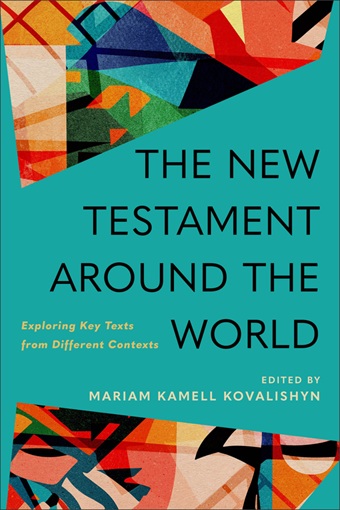 Regent College is on a roll, book-wise, with several new books by professors and several book launches in the near future.
Regent College is on a roll, book-wise, with several new books by professors and several book launches in the near future.
All the new books look good, but I’ll focus on one which might surprise those who view evangelicals as lagging behind in arts and culture (which they may be, but more bright lights are appearing all the time).
Although The Invisibility of Religion in Contemporary Art was only published last month, Comment has already posted Matthew J. Milliner’s valuable interview with its author, Jonathan A. Anderson. (And Milliner can always be counted on to find unique and interesting topics to discuss.)
Milliner began:
Previously at Material Mysticism we covered a remarkable shift in the art world from outright hostility to religion to a cautious, even occasionally enthusiastic, embrace.
Jonathan Anderson is the most responsible chronicler of that shift I am aware of. Jonathan is the Eugene and Jan Peterson Associate Professor of Theology and the Arts at Regent College.
I expect his new book, The Invisibility of Religion in Contemporary Art (2025), to be the definitive overview of the ways that contemporary art and theology intersect. The book can be purchased from University of Notre Dame Press here.
To adapt the famous remark about Karl Barth’s Epistle to the Romans, I’d call Jonathan’s book a bombshell on the playground of the art historians and art critics.
By thinking through and beyond the intellectual resources deployed by the most advanced art historians and critics, Jonathan – alongside Thomas Pfau in Incomprehensible Certainty and C.A. Tsakiridou in her remarkable trilogy – has changed the landscape of art history and criticism permanently. Whether or not those who practice such disciplines will notice that shift remains to be seen, nor does it entirely matter. The work is done, and our duty now is to rejoice.
Here is a portion of the interview:
Matthew J. Milliner: If your Oxford article [“Modern Art” (2021) in The Oxford Research Encyclopedia of Religion] is the map, I sense that your new book will be hiking the terrain itself, taking us closer to the present than you did in Modern Art and the Life of a Culture. But the world of art-making is a wilderness that changes fast. How did you delimit boundaries to what you would cover?

Regent College’s Lookout Gallery hosted Jonathan Anderson’s ‘In/Dwellings’ show earlier this year.
Jonathan A. Anderson: The Invisibility of Religion in Contemporary Art unfolds in three parts.
In part 1 I seek to understand why and how religion has been generally “invisible” and “undiscussable” in the writing about twentieth-century art. This includes two chapters titled “1979” and “2004,” which critically engage two clusters of key texts published in and around those two dates, 25 years apart. I pay special attention to October, the influential journal of art theory and criticism founded in 1976, while drawing in several other conversation partners.
These chapters show how the scholarship of modern and contemporary art has significantly under-interpreted the importance of religion in the histories of twentieth- and twenty-first-century art, and they highlight several examples of how these histories might be read differently.
Artists and artworks are ultimately the crux of the matter, but these chapters are chiefly concerned with the writing about those artists and artworks. Indeed, my argument amplifies James Elkins’s notion that “the strange place of religion in contemporary art” is less a matter of the artworks themselves than the writing about contemporary art.
In part 2 I turn to study a resurgence of interest in religion and spirituality in contemporary art since 2004, which has produced a “new visibility” and “new discussability” of these topics but in ways that are often confusing and undeveloped.
The two chapters in this part are essentially a massive expansion on my Oxford article, developing those five focal points in a more detailed way and showing exactly how those interpretive horizons have worked in major publications and exhibitions over the past two decades.
One argument that emerges here is that the same unsustainable secularization theory that has obstructed vital aspects of modern and contemporary art histories is still subtly governing current inquiries into religion and spirituality in those histories. I contend that the scholarship of modern and contemporary art cannot sufficiently address the questions of religion without more developed and historically well-resourced engagement with theology.
In part 3 I press further into what it might mean to have an open theological horizon in the study of contemporary art. Theology’s contribution to this scholarship is not a matter of coercing artists or artworks into doctrinal grids but a matter of attuning viewers to theological formations already operating within “the grain of the history of modernism.”
This re-attunement requires deeply reworking some dominant assumptions within art theory, but it only really happens through extended critical writing about particular artworks and their respective histories. Consisting of two chapters, part 3 therefore opens with a case study, an extended experiment in critical art writing that attempts to keep all four of our horizons in view, with particular attention to writing within a theological horizon.
The book then ends with an essay theorizing this kind of critical activity by rethinking it from both directions: “art criticism and theology” and “theology and art criticism.”
Go here for the full interview; there is much more. Anderson spoke here about his ‘In/Dwellings’ art show earlier this year.
More books
 There are several other books out this spring from Regent people:
There are several other books out this spring from Regent people:
- Bruce & Caroline Hindmarsh: At the Feet of Jesus: A Guide to Encountering Christ in the Gospels (InterVarsity Press): “Transform your prayer life and draw closer to Jesus. At the Feet of Jesus isn’t just another book about prayer. It’s a guided adventure into the heart of the gospel story, inviting you to step into the lives of some of Jesus’ closest friends – Mary, Martha and Lazarus.”
- Mariam Kamell Kovalishyn, editor: The New Testament Around the World: Exploring Key Texts from Different Contexts (Baker Academic): “As the church continues to expand and strengthen in non-Western contexts, it is increasingly important for students of the New Testament to be aware of how our global brothers and sisters exegete and apply Scripture.”
- Jeremy Stewart (Peter Lang): I, Daniel: An Illegitimate Reading of Jacques Derrida’s «Envois»: Part of the series New Comparative Criticism (Series Editor: Florian Mussgnug).
- Paul Stevens: Working Blessedly Forever, Volume 2 (Cascade Books): “In volume 1 of Working Blessedly Forever, Paul Stevens argues that doing marketplace theology requires head (thought), heart (prayer), and hand (action). Volume 2 takes up ‘the doing’ part through the experience of multiple practitioners thus providing a practical marketplace theology.”
And more to come later this year, from Ross Hastings: The Glory of the Ascension and no doubt others.
Book launches
The book launches are sponsored by Regent College Bookstore:
 May 21, 7:30 – 9 pm: Mariam Kamell Kovalishyn: The New Testament Around the World: Please join us for the launch of The New Testament around the World: Exploring Key Texts from Different Contexts. Dr. Mariam Kamell Kovalishyn will share the benefits of reading in community, introduce several of the book’s contributors and engage in an interactive dialogue with them as they reflect together on the intersection of biblical and cultural exegesis. The dialogue will be followed by a Q&A and a book signing with Mariam in the bookstore.
May 21, 7:30 – 9 pm: Mariam Kamell Kovalishyn: The New Testament Around the World: Please join us for the launch of The New Testament around the World: Exploring Key Texts from Different Contexts. Dr. Mariam Kamell Kovalishyn will share the benefits of reading in community, introduce several of the book’s contributors and engage in an interactive dialogue with them as they reflect together on the intersection of biblical and cultural exegesis. The dialogue will be followed by a Q&A and a book signing with Mariam in the bookstore.- May 22, 12 – 1 pm: Mary Jane Joe: Returning to the Highest Chief: Please join us at lunchtime on Thursday, May 22, for the book launch of Mary Jane Joe’s Returning to the Highest Chief: Life After Residential School. Mary Jane will read an excerpt from her new memoir, followed by an interview with Assistant Professor in the History of Christianity Dr. Prabo Mihindukulasuriya and an opportunity for questions. “This is my story about how unprepared I was coming from a cruel and sheltered, regimented life at school, and experiencing a liberated world in modern Canada, making bad choices that ultimately led to my seeking answers. Taking hold of my grandparents’ faith and approaching God the Creator in the Ntle’kepmx language was key to leading me to a born again experience.”
-

Denis Alexander
May 26, 7:30 – 9 pm: Denis Alexander: Evolution: A Story of Chance? Or a Story of Purpose?: When people hear the word ‘evolution,’ they often think that this biological theory involves only chance and random processes. This lecture will argue that this idea is mistaken. Others suggest that evolutionary history necessarily unfolds without any ultimate purpose. (This is not actually a book launch, but it would be a good opportunity to ask the founding director of the Faraday Institute in Cambridge (who is teaching a summer course at Regent) about his 2024 book, Coming to Faith Through Dawkins: 12 Essays on the Pathway from New Atheism to Christianity. Or a couple of days later (May 28, noon), when Ross Hastings will discuss with him “the intersection of science and theology.”
- July 2, 7:30 – 9 pm: Sarah Williams: When Courage Calls: “Join us to learn about the subject of Research Professor Sarah C. Williams’s most recent book, When Courage Calls: Josephine Butler and the Radical Pursuit of Justice for Women. This lecture tells the story of feminist philosopher and social activist, Josephine Butler (1828–1906). From 1869 to 1885, Butler worked tirelessly to bring to the attention of Victorian society the plight of destitute women and children caught in the sex trade. “
